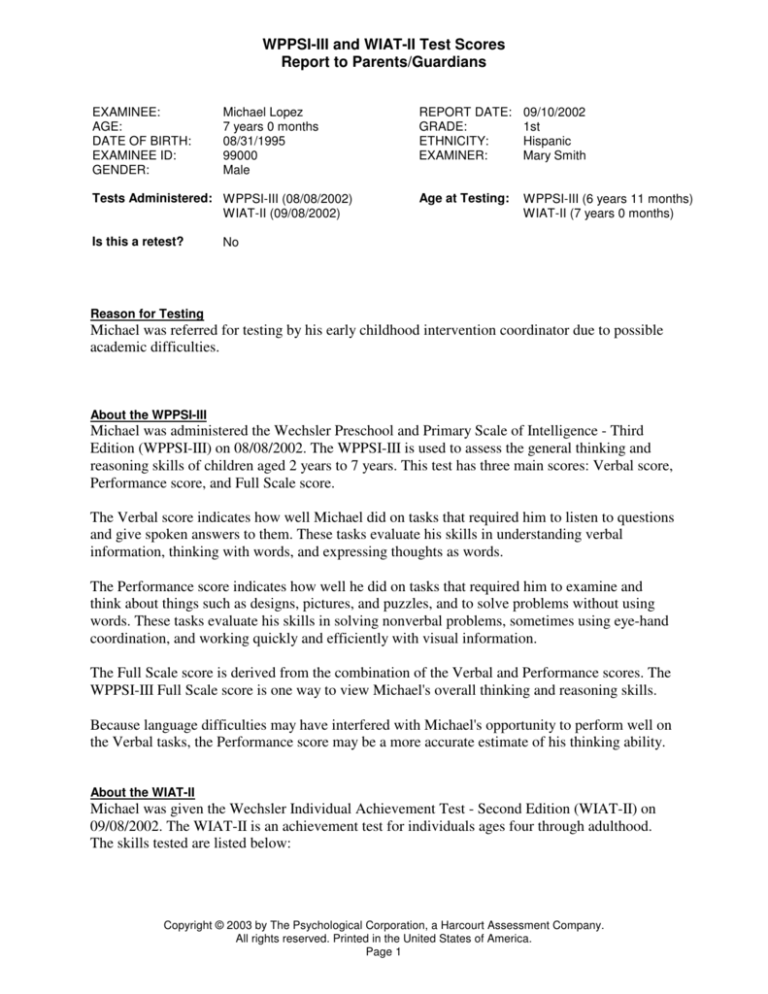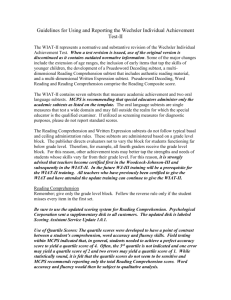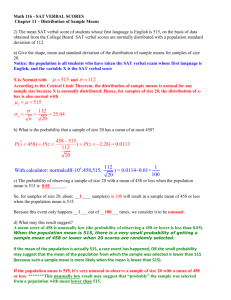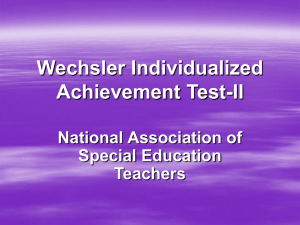
WPPSI-III and WIAT-II Test Scores
Report to Parents/Guardians
EXAMINEE:
AGE:
DATE OF BIRTH:
EXAMINEE ID:
GENDER:
Michael Lopez
7 years 0 months
08/31/1995
99000
Male
Tests Administered: WPPSI-III (08/08/2002)
WIAT-II (09/08/2002)
Is this a retest?
REPORT DATE:
GRADE:
ETHNICITY:
EXAMINER:
09/10/2002
1st
Hispanic
Mary Smith
Age at Testing:
WPPSI-III (6 years 11 months)
WIAT-II (7 years 0 months)
No
Reason for Testing
Michael was referred for testing by his early childhood intervention coordinator due to possible
academic difficulties.
About the WPPSI-III
Michael was administered the Wechsler Preschool and Primary Scale of Intelligence - Third
Edition (WPPSI-III) on 08/08/2002. The WPPSI-III is used to assess the general thinking and
reasoning skills of children aged 2 years to 7 years. This test has three main scores: Verbal score,
Performance score, and Full Scale score.
The Verbal score indicates how well Michael did on tasks that required him to listen to questions
and give spoken answers to them. These tasks evaluate his skills in understanding verbal
information, thinking with words, and expressing thoughts as words.
The Performance score indicates how well he did on tasks that required him to examine and
think about things such as designs, pictures, and puzzles, and to solve problems without using
words. These tasks evaluate his skills in solving nonverbal problems, sometimes using eye-hand
coordination, and working quickly and efficiently with visual information.
The Full Scale score is derived from the combination of the Verbal and Performance scores. The
WPPSI-III Full Scale score is one way to view Michael's overall thinking and reasoning skills.
Because language difficulties may have interfered with Michael's opportunity to perform well on
the Verbal tasks, the Performance score may be a more accurate estimate of his thinking ability.
About the WIAT-II
Michael was given the Wechsler Individual Achievement Test - Second Edition (WIAT-II) on
09/08/2002. The WIAT-II is an achievement test for individuals ages four through adulthood.
The skills tested are listed below:
Copyright © 2003 by The Psychological Corporation, a Harcourt Assessment Company.
All rights reserved. Printed in the United States of America.
Page 1
WPPSI-III and WIAT-II Test Scores
Report to Parents/Guardians
Reading:
Mathematics:
Written Language:
Oral Language:
Word Reading
Reading Comprehension
Pseudoword Decoding
Numerical Operations
Mathematics Reasoning
Spelling
Written Expression
Listening Comprehension
Oral Expression
How WPPSI-III and WIAT-II Scores are Reported
The scores show how well Michael performed compared to a group of children the same age
from across the United States. The highest possible score is 160 and the lowest possible score is
40. Half of all children will score less than 100 and half of all children will score more than 100.
Scores from 90 to 109 are average.
A percentile rank is also given. This shows your child's rank in the national comparison group. If
the percentile rank were 45, for example, it would mean that he scored higher than
approximately 45 out of 100 children his age.
When reviewing Michael's scores, remember that no test is perfectly accurate. Any child might
score slightly higher or lower if tested again on a different day.
WPPSI-III Test Scores
Scale
Verbal (VIQ)
Performance (PIQ)
General Language (GLC)
Processing Speed (PSQ)
Score
88
110
91
119
Percentile Rank
21
75
27
90
Qualitative Range
Low Average
High Average
Average
High Average
Michael's Verbal score is 88. He scored higher than approximately 21 out of 100 children his age
on tasks that require listening to questions and giving verbal responses. Generally speaking,
Michael's skills in understanding verbal information, thinking with words and expressing
thoughts in words are in the Low Average range.
His Performance score is 110. Michael scored higher than approximately 75 out of 100 children
his age on tasks that require him to examine and think about designs, pictures, and puzzles and
solve problems without using words. In general, his skills in solving nonverbal problems and
working quickly and efficiently with visual information are in the High Average range. His skills
in solving nonverbal problems are much better developed than his skills in solving verbal
problems.
Copyright © 2003 by The Psychological Corporation, a Harcourt Assessment Company.
All rights reserved. Printed in the United States of America.
Page 2
WPPSI-III and WIAT-II Test Scores
Report to Parents/Guardians
An optional score was also obtained to further assist in evaluating Michael's language skills. He
obtained a General Language Composite score of 91 which falls within the Average range
suggesting that his listening and speaking skills are similarly developed.
An additional set of tasks was administered in order to evaluate Michael's ability to quickly scan
symbols and make judgments about them. He obtained a score of 119 on the Processing Speed
Composite and scored higher than approximately 90 out of 100 children his age. In general, his
processing speed skills are within the High Average range.
WIAT-II Test Scores
Academic Area
Reading
Mathematics
Written Language
Oral Language
Score
74
94
80
80
Percentile Rank
4
34
9
9
Category
Borderline
Average
Low Average
Low Average
Michael's Reading Composite score is 74. These tasks required him to name alphabet letters,
identify and generate letter sounds and rhyming words, and match and read a series of printed
words, match words with pictures, read sentences and paragraphs and answer questions about
what was read, and to correctly apply phonetic decoding rules when reading a series of nonsense
words. These skills are better than those of approximately 4 out of 100 children his age.
Generally speaking, his skills are currently in the Borderline range.
Michael's Mathematics score is 94. These tasks assess his ability to identify and write numbers,
count, and solve basic addition and subtraction problems and to understand basic number
concepts, including unit and geometric measurement, and solve one-step word problems. His
skills are currently in the Average range and are higher than those of approximately 34 out of
100 children his age.
Michael's Written Language score is 80. The writing tasks required him to write one's name and
print letters that correspond to sounds and words and to write the alphabet from memory,
generate words within a category, generate sentences to describe visual cues, and combine
sentences. His skills are currently in the Low Average range and are higher than those of
approximately 9 out of 100 children his age.
Michael's Oral Language score is 80. The language tasks assess his ability to identify the picture
that best represents an orally presented descriptor or generate a word that matches the picture and
to repeat sentences, generate words within a category, describe scenes, and give directions. His
skills are currently in the Low Average range and are higher than those of approximately 9 out
of 100 children his age.
Copyright © 2003 by The Psychological Corporation, a Harcourt Assessment Company.
All rights reserved. Printed in the United States of America.
Page 3
WPPSI-III and WIAT-II Test Scores
Report to Parents/Guardians
Your child may benefit from your support and encouragement in helping him improve his skills
in Reading, Written Language, and Oral Language. If you have not already done so, you may
wish to talk with Mary Smith regarding a plan for assisting Michael in improving these skills.
The WPPSI-III is a test of thinking and reasoning skills and the WIAT-II is a test of academic
achievement. A child's scores on these tests, however, can also be influenced by motivation,
attention, interests, and opportunities for learning. Please keep in mind that a few test scores
cannot assess all of the skills that Michael may be capable of using to assist him in achieving
success.
__________________________________
Mary Smith
Copyright © 2003 by The Psychological Corporation, a Harcourt Assessment Company.
All rights reserved. Printed in the United States of America.
Page 4








